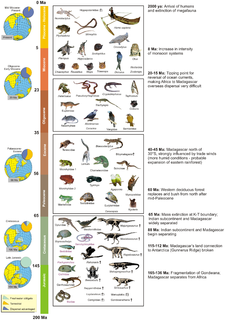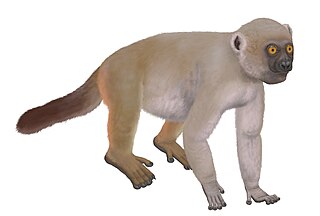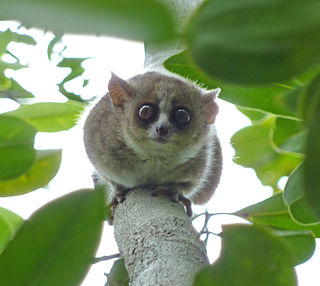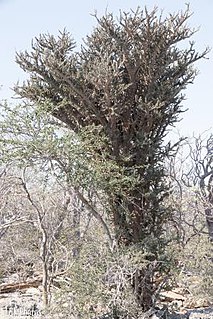
Lemuridae is a family of strepsirrhine primates native to Madagascar and the Comoros Islands. They are represented by the Lemuriformes in Madagascar with one of the highest concentration of the lemurs. One of five families commonly known as lemurs. These animals were once thought to be the evolutionary predecessors of monkeys and apes, but this is no longer considered correct.

The Afrotropical realm is one of Earth's eight biogeographic realms. It includes Africa south of the Sahara Desert, the majority of the Arabian Peninsula, the island of Madagascar, southern Iran and extreme southwestern Pakistan, and the islands of the western Indian Ocean. It was formerly known as the Ethiopian Zone or Ethiopian Region.

Pachypodium is a genus of succulent spine-bearing trees and shrubs, native to Madagascar and Africa. It belongs to the family Apocynaceae.

Lemurs are mammals of the order Primates, divided into 8 families and consisting of 15 genera and around 100 existing species. They are native only to the island of Madagascar. Most existing lemurs are small, have a pointed snout, large eyes, and a long tail. They chiefly live in trees (arboreal), and are active at night (nocturnal).

The Madagascar lowland forests or Madagascar humid forests are a tropical moist broadleaf forest ecoregion found on the eastern coast of the island of Madagascar, home to a plant and animal mix that is 80 to 90% endemic, with the forests of the eastern plain being a particularly important location of this endemism. They are included in the Global 200 list of outstanding ecoregions.

Didiereaceae is a family of flowering plants found in continental Africa and Madagascar. It contains 20 species classified in three subfamilies and six genera. Species of the family are succulent plants, growing in sub-arid to arid habitats. Several are known as ornamental plants in specialist succulent collections. The subfamily Didiereoideae is endemic to the southwest of Madagascar, where the species are characteristic elements of the spiny thickets.

Alluaudia procera, or Madagascar ocotillo, is a deciduous succulent plant species of the family Didiereaceae. It is endemic to south Madagascar.

The fauna of Madagascar is a part of the wildlife of Madagascar.

The Madagascar spiny forests is an ecoregion in the southwest of Madagascar. The vegetation type is found on poor substrates with low, erratic winter rainfall. The ecoregion contains an outstanding proportion of endemic plant species and is listed as one of the 200 most important ecological regions in the world; one of the Global 200.

The composition of Madagascar's wildlife reflects the fact that the island has been isolated for about 88 million years. The prehistoric breakup of the supercontinent Gondwana separated the Madagascar-Antarctica-India landmass from the Africa-South America landmass around 135 million years ago. Madagascar later split from India about 88 million years ago, allowing plants and animals on the island to evolve in relative isolation.

The white-footed sportive lemur, white-footed weasel lemur, or dry-bush weasel lemur is a species of lemur in the family Lepilemuridae, the sportive lemurs. It is similar in appearance to other lemurs in the family, with a grey back, a pale grey to white ventral side, and a light brown tail. It is a nocturnal animal that moves through the forest using a vertical clinging and leaping technique. It is endemic to Madagascar, inhabiting the southern subtropical or tropical dry shrubland. It is threatened by habitat loss due to agriculture practices and charcoal production.

Tsimanampetsotsa National Park also spelt Tsimanampetsotse, and known as Tsimanampetsotsa Nature Reserve is a 432 km2 national park on the south-west coast of Madagascar in the region Atsimo-Andrefana. The park is 90 kilometres (56 mi) south of Toliara and 950 kilometres (590 mi) south of the capital, Antananarivo. Route Nationales (RN) 10 to Faux Cap passes the park and the nearest airport is at Toliara. The national park contains and is named after Lake Tsimanampetsotsa.

The monkey lemurs or baboon lemurs (Archaeolemuridae) are a recently extinct family of lemurs known from skeletal remains from sites on Madagascar dated to 1000 to 3000 years ago.

Pachylemur is an extinct, giant lemur most closely related to the ruffed lemurs of genus Varecia. Two species are known, Pachylemur insignis and Pachylemur jullyi, although there is some doubt as to whether or not they may actually be the same species. Pachylemur is sometimes referred to as the giant ruffed lemur, because although it and the living ruffed lemurs had similar teeth and skeletons, Pachylemur was more robust and as much as three to four times larger. DNA studies have confirmed a sister group relationship between these two types of lemur. Like living ruffed lemurs, Pachylemur specialized in eating fruit, and was therefore an important seed disperser, possibly for tree species with seeds too large for even ruffed lemurs to swallow. In the spiny thickets of southwestern Madagascar, they were also likely to have dispersed seeds evolved to attach to fur and be carried away. Unlike ruffed lemurs, the fore- and hindlimbs of Pachylemur were nearly the same length, and therefore it was likely to be a slow, deliberate climber. However, both used hindlimb suspension to reach fruit on small branches below them.

Hadropithecus is a medium-sized, extinct genus of lemur, or strepsirrhine primate, from Madagascar that includes a single species, Hadropithecus stenognathus. Due to its rarity and lack of sufficient skeletal remains, it is one of the least understood of the extinct lemurs. Both it and Archaeolemur are collectively known as "monkey lemurs" or "baboon lemurs" due to body plans and dentition that suggest a terrestrial lifestyle and a diet similar to that of modern baboons. Hadropithecus had extended molars and a short, powerful jaw, suggesting that it was both a grazer and a seed predator.

Babakotia is an extinct genus of medium-sized lemur, or strepsirrhine primate, from Madagascar that contains a single species, Babakotia radofilai. Together with Palaeopropithecus, Archaeoindris, and Mesopropithecus, it forms the family Palaeopropithecidae, commonly known as the sloth lemurs. The name Babakotia comes from the Malagasy name for the indri, babakoto, to which it and all other sloth lemurs are closely related. Due to its mix of morphological traits that show intermediate stages between the slow-moving smaller sloth lemurs and the suspensory large sloth lemurs, it has helped determine the relationship between both groups and the closely related and extinct monkey lemurs.

Lemurs, primates belonging to the suborder Strepsirrhini which branched off from other primates less than 63 million years ago, evolved on the island of Madagascar, for at least 40 million years. They share some traits with the most basal primates, and thus are often confused as being ancestral to modern monkeys, apes, and humans. Instead, they merely resemble ancestral primates.

Subfossil lemurs are lemurs from Madagascar that are represented by recent (subfossil) remains dating from nearly 26,000 years ago to approximately 560 years ago. They include both extant and extinct species, although the term more frequently refers to the extinct giant lemurs. The diversity of subfossil lemur communities was greater than that of present-day lemur communities, ranging from as high as 20 or more species per location, compared with 10 to 12 species today. Extinct species are estimated to have ranged in size from slightly over 10 kg (22 lb) to roughly 160 kg (350 lb). Even the subfossil remains of living species are larger and more robust than the skeletal remains of modern specimens. The subfossil sites found around most of the island demonstrate that most giant lemurs had wide distributions and that ranges of living species have contracted significantly since the arrival of humans.

Alluaudia montagnacii is a rare species of flowering plants belonging to the family Didiereaceae.

Alluaudia comosa is a rare species of flowering plant. It belongs to the family Didiereaceae, subfamily Didiereoideae, which is found only in the coastal area of SW Madagascar. Didierea comosa Drake is a synonym. It is listed as "vulnerable" on the IUCN Red List of Threatened Species.

























